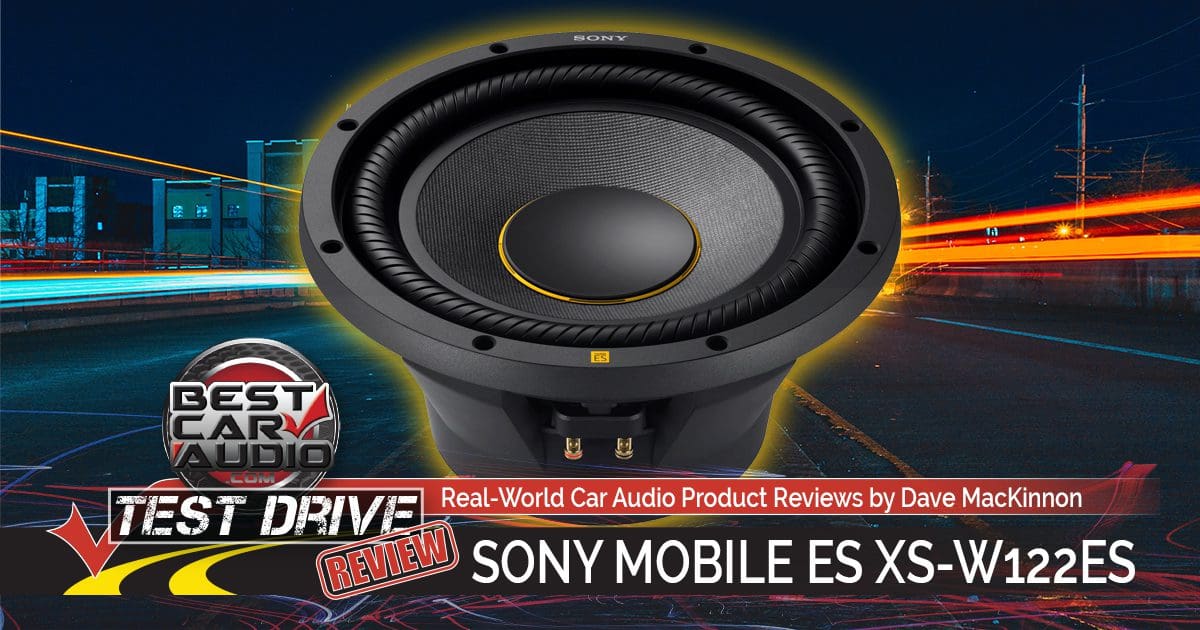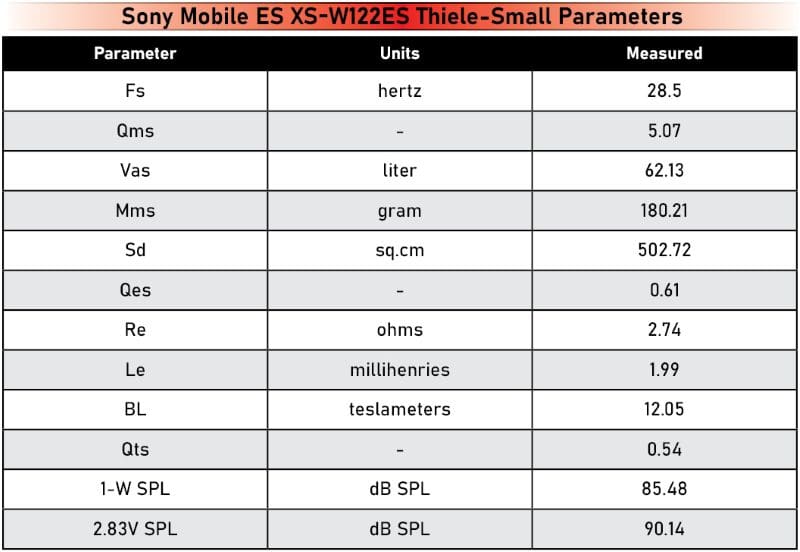As you may know, the product development team at Sony has been busy over the last few years creating an entirely new line of premium car audio products. Their efforts have rewarded the industry with the amazing XAV-9500ES multimedia receiver, as well as six speaker solutions, three amplifiers and three subwoofer offerings. In this Test Drive Review, we’ll inspect and evaluate the XS-W122ES 12-inch subwoofer.
Features of the Sony XS-W122ES Car Audio Subwoofer
The XS-W122ES is one of two 12-inch subwoofers in the Mobile ES series. This driver has a voice coil wound to a nominal impedance of 2 ohms, while its brother, the XS-W124ES, has a 4-ohm impedance. Besides the voice coil impedance, both drivers’ design elements are equal. Sony rates both drivers as capable of handling 500 watts of power continuously, with peaks of 2,000 watts.
The XS-W122ES is based on a heavy-gauge stamped steel basket with five spokes. The basket is concealed by a custom injection-molded shroud that covers the dual ceramic magnet motor assembly and provides that cast-basket look. Sony knows that keeping the voice coil cool at high volume levels is crucial to managing power compression. As such, they have integrated their Dynamic Air Diffuser technology into that shroud and the spider mounting spacer. Hot air from around the motor and under the spider can escape easily and mix with the air in the enclosure to help cool things. A large-radiused vent in the bottom of the T-yoke offers similar cooling for the inside of the motor assembly and voice coil and helps prevent pressure from building under the dust cap as the cone moves forward and rearward. Pressure management is an essential part of ensuring that the driver operates linearly at high output levels.
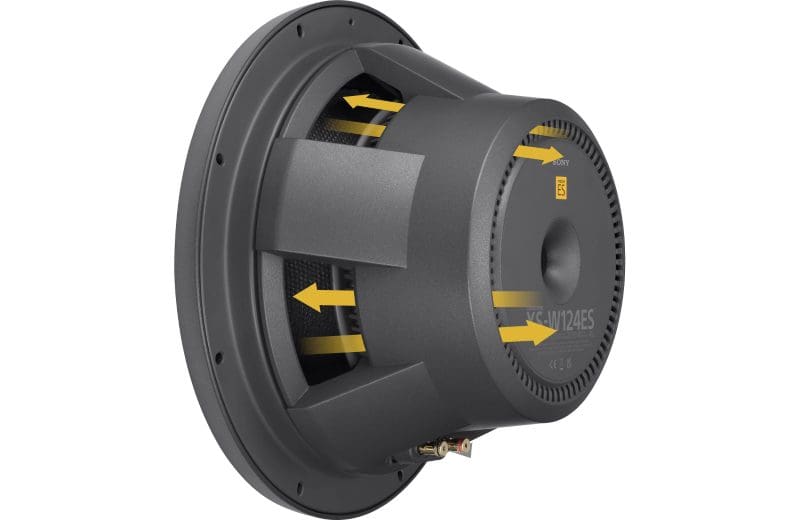
Electrical connections are made via a pair of gold-plated spring-loaded terminals on the side of the chassis. The terminals will accept up to 10 AWG cables to ensure reliable power delivery. From there, power is fed to the voice coil by a pair of tinsel leads sewn to one of the spiders. Likewise, the subwoofer has two spiders to help ensure that the cone moves linearly and doesn’t rock and damage the voice coil winding.
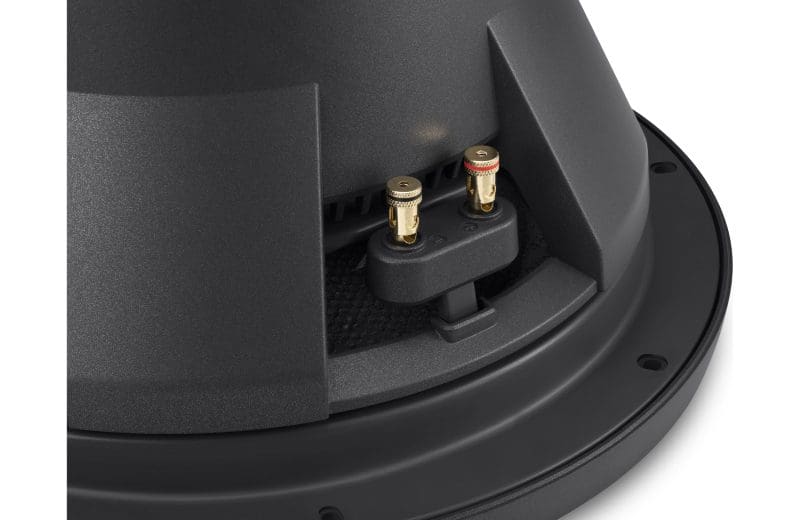
A custom-tooled rubber Separated Notch Edge Surround provides upper compliance for the cone. The grooves integrated into the surround allow it to stretch as the cone moves and helps to prevent resonances that can add distortion. The woofer cone uses Sony’s proprietary Lightweight Rigid Cellular Honeycomb material. This material is 10 times more rigid than a polypropylene cone to help prevent distortion and deformation at high excursion levels. The center of the cone features an injection-molded, inverted polypropylene dust cap to keep debris out of the voice coil gap.
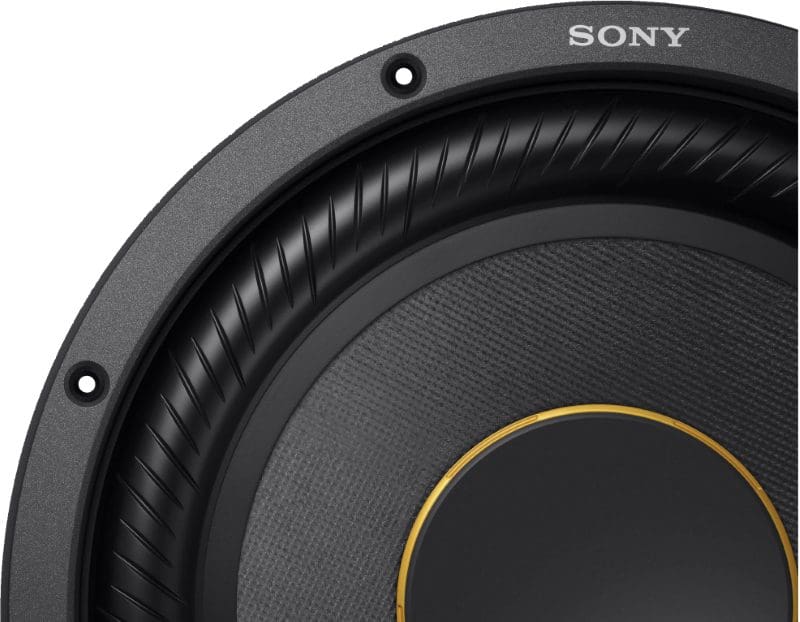
Sony includes an injection-molded plastic trim ring that covers the mounting flange for a neat appearance once installed. The trim has the same finish as the basket and motor shroud and proudly bears the yellow Mobile ES at the bottom.
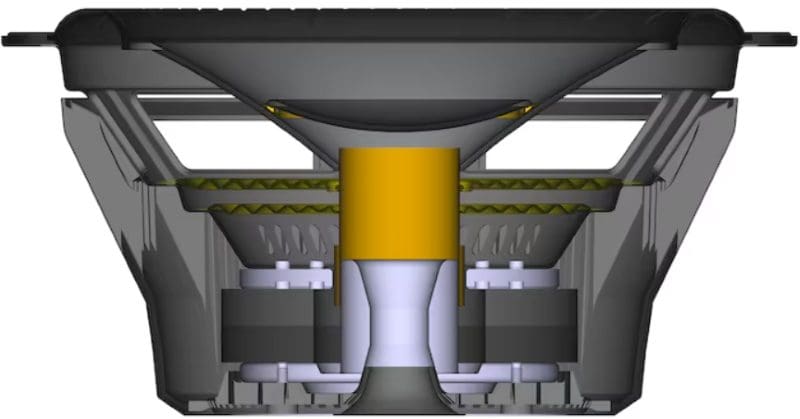
In terms of applications, the owner’s manual recommends either a 0.84-cubic-foot acoustic suspension (sealed) enclosure or a bass reflex (vented) design with a net internal volume of 1.34 cubic feet and a tuning frequency of 34.46 hertz. This is a great tuning frequency as it should balance output with low-frequency extension.
Measuring the Mobile ES SX-W122ES
As always, I started my evaluation by measuring the Thiele/Small parameters of the XS-W122ES subwoofer right out of the gift box. I do this to see how much they might change after being broken in. Not all drivers change; the only way to know if they will is to use them. Unlike breaking in a new car or truck engine, the speaker’s longevity isn’t reliant on the process. You don’t need to be gentle with them. Crank up your music and enjoy. If the suspension softens, they’ll play deeper after a hundred hours or so of playtime. In the case of these subwoofers, the infinite baffle resonant frequency dropped from 35.14 down to 28.5 hertz, which is significant. The equivalent compliance (Vas) softened from 47.35 to 62.13 liters, which is also substantial. It was well worth breaking these subwoofers in before performing a final equalizer calibration.
Looking at the specifications, the DC resistance is a little high for a 2-ohm driver at 2.7 ohms. Combined with the reactance, this would act more like a 3-ohm driver. This would be a very easy load for an amp to drive. The equivalent compliance is soft at just over 62 liters, and with a resonant frequency below 30 Hz, this driver should do a good job reproducing near-infrasonic information. The voice coil inductance is a bit high at just under 2 millihenries, so you’ll want your midbass speakers to be robust. Most crucially regarding sound quality, the Qts is reasonably low at 0.543, so the bass produced in a properly designed enclosure shouldn’t be sloppy or boomy.
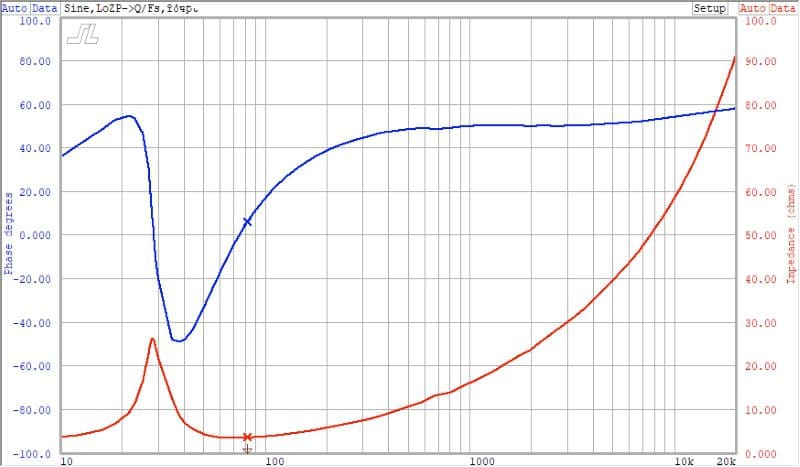
I loaded the measured parameters into Bass Box Pro for some application analysis. First, I analyzed the suggested 0.84-cubic-foot acoustic suspension enclosure, offering a total system Q (Qtc) of 0.899 with an F3 frequency of 46.3 hertz. You can drop the Q closer to 0.7 by stuffing about a pound of polyfill into the enclosure. Just be sure to keep it away from the cooling vents in the subwoofer.
The suggested bass reflex enclosure has a net internal air volume of 1.44 cubic feet and is tuned to 35 hertz. The bass reflex system increases low frequency output significantly, and this system is more efficient down to below 20 Hz compared with the acoustic suspension design. The vent velocity gets a bit high when driven with the full 500 watts, so I’d suggest 400 watts is a better maximum. Sony rates the XS-W122ES as having an Xmax of 7.7 millimeters. I was able to coax more cone excursion out of the driver during the break-in process. Nevertheless, for both the bass reflex and acoustic suspension designs, the 7.7 mm excursion limit also becomes an issue above 400 watts.
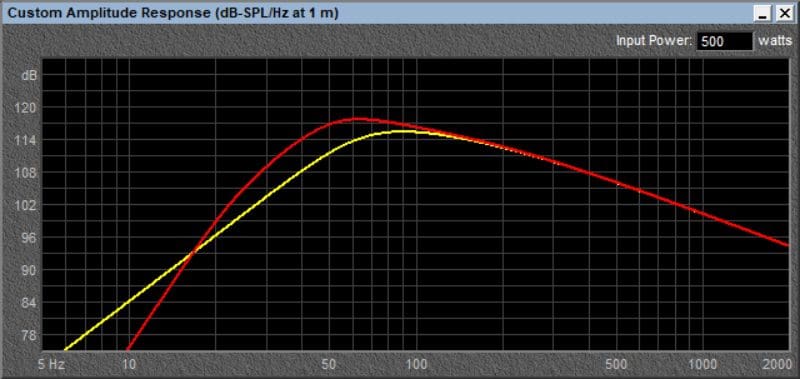
Next, I modeled the pair of drivers in the large vented enclosure I have on loan from Lee Mattason from Burlington Radioactive. This enclosure has a net internal volume of 3.8 cubic feet and is tuned to just over 34 Hz. The extra volume increases output a bit at 40 hertz over the Sony-specified design, but only by a decibel or two. This should work fine for the listening evaluation.
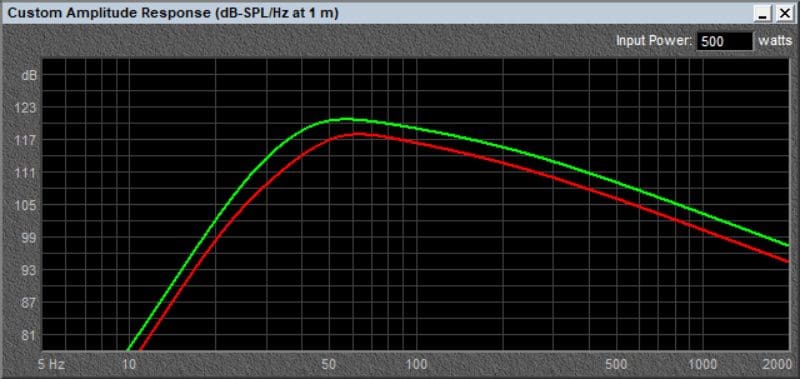
Auditioning the Sony Mobile ES 12-Inch Subwoofers
I installed both drivers into the test enclosure and wired them in parallel. Next, I connected the subs to my 2,500-watt monoblock amplifier and set a low-pass filter on the radio at 80 Hz with a -18 dB/octave filter. My bookshelf speakers are connected to a high-bias Class AB amp, and they are filtered at 80 Hz with the same filter slope. Finally, I adjusted the output of the subwoofers to match my target acoustic response curve in my listening room, then sat back for a listen.
The first track I played was “Blue Monday” by New Order. I use this track to gauge the tightness of the upper frequencies from a subwoofer. I was apprehensive about the results, given the moderate inductance of the drivers. Thankfully, and perhaps impressively, those fears were unfounded. The Sonys had no problem blending nicely with tower speakers and their 5-inch woofers to deliver taught and well-controlled midbass. Very cool!

The next track was “Chocolate Chip Trip” by Tool from their Fear Inoculum album. With that track, my goal was to evaluate the subwoofers’ ability to be musically accurate. The percussion in this track is recorded exceptionally well. Even with the bass level calibrated more toward what would be suitable in a car, the realism in the sound of the hammer hitting the skin of the kick drum was amazing. It sounded like the drum kit was six feet tall and filled the end of the room. Other than the size, it sounded impressively realistic.
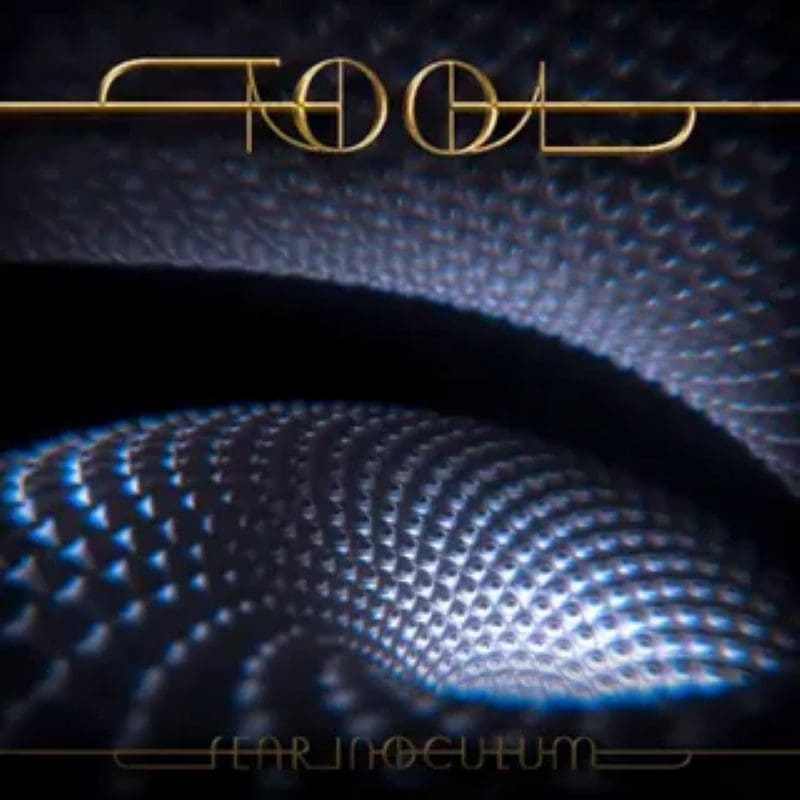
The last track was chosen to evaluate low-frequency extension. It’s important to remember that I’m in a several-hundred-square-foot room and not in a car. As such, I don’t have the benefit of the cabin at low frequencies that I would in a vehicle. Nevertheless, I chose “Jurassic Lunch” from The Great Fantasy Adventure Album by Erich Kunzel and the Cincinnati Pops Orchestra. This isn’t a song per se; it’s a subwoofer-destroying, amplifier-clipping demo track. At the 13-second point, there’s a low-frequency rumble focusing on the range from 10 to 30 Hz. This is intended to mimic the footsteps of a Tyrannosaurus rex. The footsteps repeat until the beast breaks through the trees and delivers a giant roar before gobbling up its victim. The Sony subwoofers reproduced the rumble even with the enclosure’s ~35 Hz tuning frequency. The enclosure isn’t designed as a home theater solution, so the bottom octave (10 to 20 Hz) suffers somewhat. I noted that there were no unwanted noises from the subwoofers or the enclosure, even at high-excursion levels and output that’s an octave below the vent’s resonant frequency. In a car or SUV, this track would be excellent!
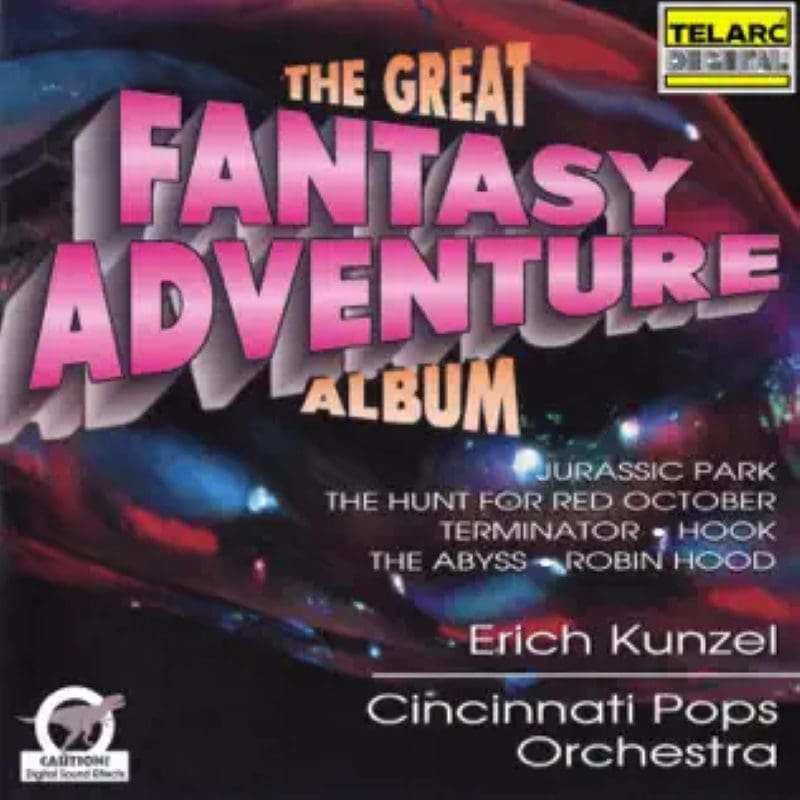
Conclusions on the Sony XS-W122ES Subwoofers
Before we get into the specifics of the Sony subwoofers themselves, there’s an important lesson to learn from this review. If you’ve read any of my articles on speaker quality, then you know that distortion increases dramatically with cone excursion. Nonlinearities in motor strength, inductance and suspension design can add significant unwanted harmonic information when the cone moves more than a few millimeters in each direction. This applies to every speaker, in every size, from every brand. Until now, all the Test Drive Reviews we’ve published have been with a single 10-inch subwoofer. The difference in having a pair of 12-inch drivers present is massive. We are talking about 2.8 times as much cone area at 156 square inches compared with about 55 inches for a single 10.
A not-so-quick computer simulation shows the 12’s only need 44 watts to produce 110 dB of output at 50 Hz. Cone excursion would be 1.75 mm at this level. A single 10 needs 116 watts to produce the same 110 dB of output and requires just over 3 millimeters of excursion. The comparison isn’t perfect, as enclosure tuning and response differences exist. Nevertheless, the concept is clear: More power and more excursion from a single or small driver result in more distortion at a given volume level. Having a few large subwoofers is a great way to improve the clarity of your car’s audio system. Keep this in mind when you have the product specialist at a local retailer design your car audio system.
So, how did the Sony XS-W122ES subwoofers sound? I was extremely impressed with the clarity and realism produced by these drivers. Drums, synthesizers and even the challenging-to-reproduce upright bass all sounded amazingly detailed and realistic. As I mentioned, I was apprehensive about the moderate level of voice coil inductance affecting the midbass region, but it wasn’t an issue during my listening tests. I think Sony has done an excellent job designing the 12-inch Mobile ES subwoofers, and they are well worth consideration in your car audio system.
Drop by a local authorized Sony Mobile ES retailer and ask for a demonstration. To learn more about the Mobile ES line of car audio upgrades, visit their website or Facebook page.
